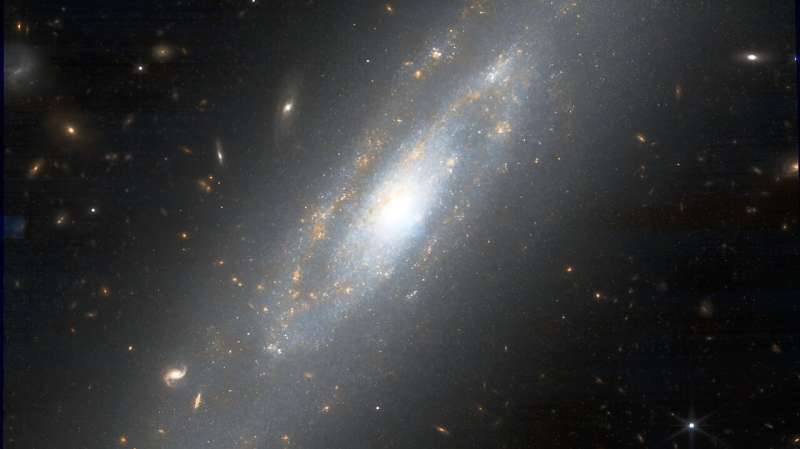Fresh Examination of Webb Data Assesses Universe's Expansion Rate, Suggests Potential Resolution to 'Hubble Tension'

August 14, 2024
This article has been reviewed according to Science X's editorial process and policies. Editors have highlighted the following attributes while ensuring the content's credibility:
- fact-checked
- peer-reviewed publication
- trusted source
- proofread
by Louise Lerner, University of Chicago
We know many things about our universe, but astronomers are still debating exactly how fast it is expanding. In fact, over the past two decades, two major ways to measure this number—known as the 'Hubble constant'—have come up with different answers, leading some to wonder if there was something missing from our model of how the universe works.
But new measurements from the powerful James Webb Space Telescope seem to suggest that there may not be a conflict, also known as the 'Hubble tension,' after all.
In a paper submitted to The Astrophysical Journal, currently available on the arXiv preprint server, University of Chicago cosmologist Wendy Freedman and her colleagues analyzed new data taken by NASA's powerful James Webb Space Telescope. They measured the distance to 10 nearby galaxies and measured a new value for the rate at which the universe is expanding at the present time.
Their measurement, 70 kilometers per second per megaparsec, overlaps the other major method for the Hubble constant.
'Based on these new JWST data and using three independent methods, we do not find strong evidence for a Hubble tension,' said Freedman, renowned astronomer and the John and Marion Sullivan University Professor in Astronomy and Astrophysics at the University of Chicago. 'To the contrary, it looks like our standard cosmological model for explaining the evolution of the universe is holding up.'
We have known the universe is expanding over time ever since 1929, when UChicago alum Edwin Hubble (SB 1910, Ph.D. 1917) made measurements of stars that indicated the most distant galaxies were moving away from the Earth faster than nearby galaxies. But it has been surprisingly difficult to pin down the exact number for how fast the universe is expanding at the current time.
This number, known as the Hubble constant, is essential for understanding the backstory of the universe. It's a key part of our model of how the universe is evolving over time.
'Confirming the reality of the Hubble constant tension would have significant consequences for both fundamental physics and modern cosmology,' explained Freedman.
Given the importance and also the difficulty in making these measurements, scientists test them with different methods to make sure they're as accurate as possible.
One major approach involves studying the remnant light from the aftermath of the Big Bang, known as the cosmic microwave background. The current best estimate of the Hubble constant with this method, which is very precise, is 67.4 kilometers per second per megaparsec.
The second major method, which Freedman specializes in, is to measure the expansion of galaxies in our local cosmic neighborhood directly, using stars whose brightnesses are known. Just as car lights look fainter when they are far away, at greater and greater distances, the stars appear fainter and fainter. Measuring the distances and the speed at which the galaxies are moving away from us then tells us how fast the universe is expanding.
In the past, measurements with this method returned a higher number for the Hubble constant—closer to 74 kilometers per second per megaparsec.
This difference is large enough that some scientists speculate that something significant might be missing from our standard model of the universe's evolution. For example, since one method looks at the earliest days of the universe and the other looks at the current epoch, perhaps something large changed in the universe over time. This apparent mismatch has become known as the 'Hubble tension.'
The James Webb Space Telescope or JWST, offers humanity a powerful new tool to see deep into space. Launched in 2021, the successor to the Hubble Telescope has taken stunningly sharp images, revealed new aspects of faraway worlds, and collected unprecedented data, opening new windows on the universe.
Freedman and her colleagues used the telescope to make measurements of ten nearby galaxies that provide a foundation for the measurement of the universe's expansion rate.
To cross-check their results, they used three independent methods. The first uses a type of star known as a Cepheid variable star, which varies predictably in its brightness over time. The second method is known as the 'Tip of the Red Giant Branch,' and uses the fact that low-mass stars reach a fixed upper limit to their brightnesses.
The third, and newest, method employs a type of star called carbon stars, which have consistent colors and brightnesses in the near-infrared spectrum of light. The new analysis is the first to use all three methods simultaneously, within the same galaxies.
In each case, the values were within the margin of error for the value given by the cosmic microwave background method of 67.4 kilometers per second per megaparsec.
'Getting good agreement from three completely different types of stars, to us, is a strong indicator that we're on the right track,' said Freedman.
'Future observations with JWST will be critical for confirming or refuting the Hubble tension and assessing the implications for cosmology,' said study co-author Barry Madore of the Carnegie Institution for Science and visiting faculty at the University of Chicago.
More information: Wendy L. Freedman et al, Status Report on the Chicago-Carnegie Hubble Program (CCHP): Three Independent Astrophysical Determinations of the Hubble Constant Using the James Webb Space Telescope, arXiv (2024). DOI: 10.48550/arxiv.2408.06153
Journal information: Astrophysical Journal, arXiv
Provided by University of Chicago




